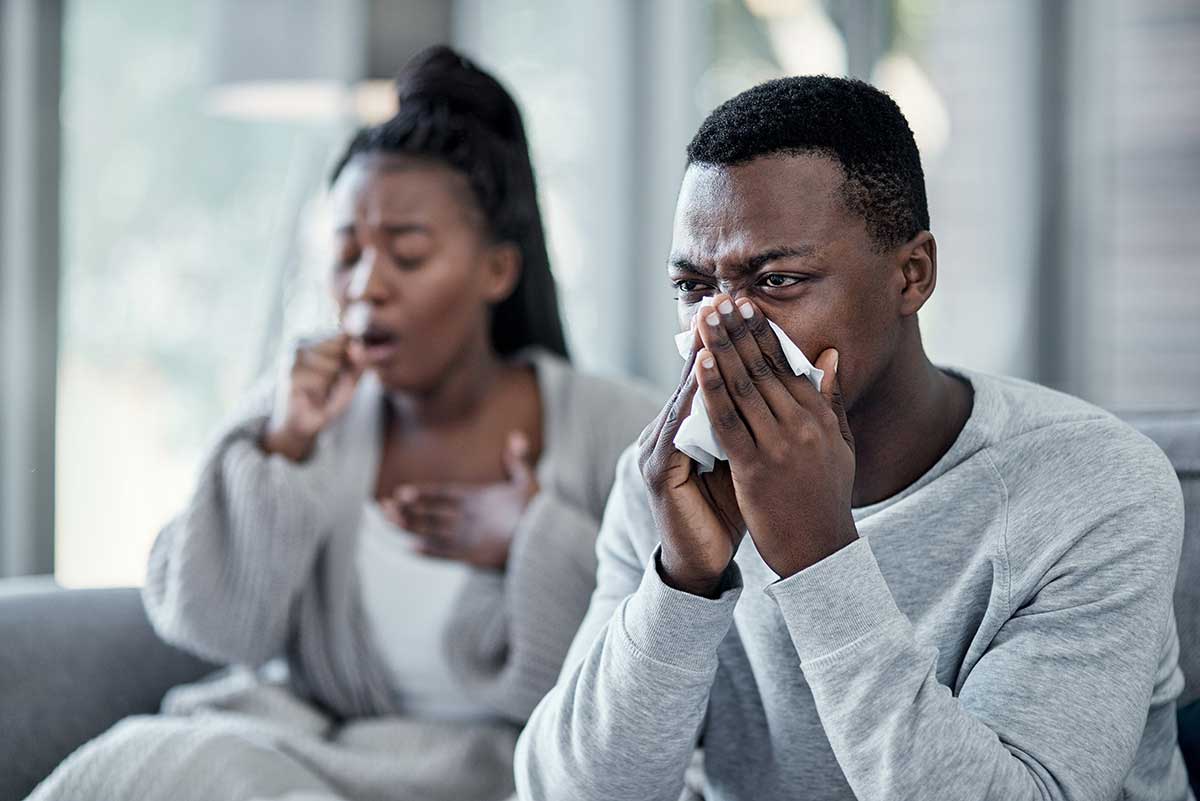Although people may dismiss any illness they get during the winter as “seasonal flu,” the truth is there are several respiratory viral infections that occur in winter. The symptoms are often very similar at first, but the Center for Disease Control and Prevention (CDC) recommends different treatment depending on the virus that has infected you.
It is important to have a quick and effective test to determine which virus is causing your infection. Knowing the virus responsible for your symptoms helps your healthcare provider choose the most effective treatment.
Rapid PCR tests have proven invaluable for detecting and identifying respiratory viral infections. These viruses can cause serious illness, and some people are more at risk than others for developing significantly worse symptoms once infected. This post reviews respiratory viral infections, when they occur, and why anti-viral testing is important.
What are the most common respiratory viral infections?
Even though these viruses (as well as bacterial and other types of respiratory infections) exhibit similar symptoms, COVID-19, the influenza viruses types A and B, and respiratory syncytial virus have some important differences.

COVID-19
COVID-19 is a coronavirus. It first emerged in late 2019 in China. At the time it emerged, COVID-19 was a new type of coronavirus for which there was no natural human immunity. It is highly contagious and easily spread resulting in a global pandemic. The international community continues to struggle with containing the virus and recovering from the social and economic consequences of the pandemic.
COVID-19 is spread by coughing or sneezing and inhaling respiratory droplets from an infected person. The shape of the virus with its spike proteins allows it to attach to cells and cause infection. Common symptoms include the following1:
- Fever
- Tiredness or fatigue
- Muscle aches
- Headaches
- Nasal congestion
- Loss of taste and/or smell
- Sore throat
- Cough
- Shortness of breath
- Nausea or vomiting
- Diarrhea
Older adults and people with chronic conditions are at greater risk of complications such as respiratory failure, stroke, neurologic problems, kidney failure, heart problems, and death.
Some people who are infected with COVID-19 and even those with mild infections go on to develop prolonged symptoms called “long COVID.”
COVID-19 is best prevented by vaccination.
Influenza Types A and B
The influenza (flu) viruses types A and B are responsible for the annual flu season in the United States and other regions of the world. Influenza type A has also been responsible for pandemics such as the 1918 influenza pandemic. Influenza type A spreads between humans and can spread from animals to humans. Influenza type B only spreads between humans.
These flu viruses are spread by coughing, sneezing, or talking. People 6 feet away can spread the flu virus to someone else who gets infected by inhaling respiratory droplets. People can also become infected by touching objects contaminated with the flu virus such as doorknobs or keyboards
The onset of symptoms for the flu is sudden and often quite severe. Common symptoms include the following2:
- Fever
- Cough
- Sore throat
- Runny nose
- Muscle and body aches
- Fatigue
- Vomiting (mostly in children)
People most at risk for complications are those over age 65, who have asthma, diabetes, and heart disease, pregnant women, and children under age 5. Complications include pneumonia, heart (myocarditis), brain (encephalitis), or muscle (rhabdomyolysis) inflammation, and kidney or other organ failure.
Influenza types A and B are best prevented by a yearly vaccination. The influenza viruses change each year, and the vaccines are changed based on the most likely version of influenza types A and B viruses circulating for the year.
Respiratory Syncytial Virus
Respiratory syncytial virus (RSV) causes respiratory infections each year like the other respiratory viruses. This virus is also spread by respiratory droplets from coughing, sneezing, or talking. It is also spread by touching contaminated surfaces like doorknobs and can survive for extended periods of time on surfaces. It can spread by direct contact such as kissing a child with RSV.
Symptoms for most children and adults are mild and can occur in stages rather than all at once. Children may experience the following3:
- Sneezing
- Runny nose
- Cough
- Wheezing
- Decreased appetite
Adults usually have common cold type symptoms – runny nose, sore throat, cough, headache, and fatigue. Adults recover in 5 days or less.

However, for infants, an RSV infection can be life-threatening. Complications include pneumonia and bronchiolitis. Up to 2% of children under age 6 months must be hospitalized yearly because of RSV4. Very young infants may only show irritability, a decrease in activity, or periods where they briefly stop breathing. Treatment can include oxygen or a ventilator (breathing machine) depending on severity.
People most at risk for severe illness are premature infants or those less than 6 months of age, children less than 2 years of age with chronic lung or congenital heart problems, and those with immune system deficiency or muscular disorders. Adults aged 65 or older or those with heart or lung disease are most at risk for severe illness.
Unfortunately, there is no vaccine for RSV.
What factors contribute to increased respiratory viral infections in the fall and winter?
The fall and winter seasons increase the circulation of respiratory infections because of several factors – lower vitamin D levels, more time spent indoors, and decreased ability to prevent respiratory viral infections5.
- Lower vitamin D levels. In fall and winter, sun exposure declines and less vitamin D is made, which weakens the immune system. Vitamin D supplementation is not common for most people.
- More time spent indoors. Cold temperatures push people to spend more time indoors. More time spent indoors means a greater chance of exposure to respiratory viruses.
- Decreased ability to prevent infection. Fall and winter means exposure to colder temperatures. Breathing cold air reduces our white blood cells’ ability to reach the mucus membranes in the nose and throat to kill any virus that invades the respiratory tract.
The cold temperatures and weakened immune systems in the fall and winter increase the risk of respiratory viral infections and the chance of developing severe illness, thus the name “flu season.”
Why is identifying a specific respiratory virus important?
The introduction of COVID-19 to the roster of diseases that commonly affect human populations during the fall and winter months has made preventive care for respiratory illnesses more difficult. Regular COVID-19 PCR testing should not decrease as vaccination levels rise for the following reasons:
- Fully vaccinated people may contract COVID-19 and require treatment
- COVID-19 mutates frequently and booster shots and additional vaccines will be required
- Sizeable portions of the world’s population are not vaccinated increasing the likelihood of COVID-19 mutation

While the COVID-19 pandemic seems to be nearing an end in some parts of the world because of more fully vaccinated people, the virus will continue to impact the flu season for the near future. Regular COVID-19 PCR testing decreases hospitalizations, guides treatment, determines the appropriate anti-viral medication, and tracks COVID-19 and influenza virus activity.
Hospitalizations
Regular testing of suspected COVID-19 cases prevents unnecessary hospitalizations and frees up hospital beds for people who need them the most. Rapid testing of symptomatic high-risk age groups allows medical professionals to devise an early treatment plan potentially reducing the need for hospitalization. Waiting until a person develops difficulty breathing or chest pain may be too late.
Treatment Guidance
Knowing which virus a person does not have can guide treatment more often than knowing exactly what virus or bacteria is causing symptoms. A rapid PCR test that rules out a COVID-19 infection makes treating a patient with flu-like symptoms easier.
Anti-viral Medication
During the early phases of the pandemic, there were no anti-viral drugs to treat COVID-19. Thankfully, anti-viral medications specifically targeting COVID-19 are now available. Rapid COVID-19 PCR testing allows providers to prescribe this medication within the window of time when it is most effective. These medications are designed to shorten the course of illness and prevent hospitalization.
The Bottom Line
The respiratory viral infections COVID-19, influenza types A and B, and RSV all circulate during the winter months. Rapid PCR testing can differentiate between these infections and guide treatment for selecting the appropriate anti-viral medication.
As a bonus, organized rapid PCR testing can help normalize life. A test to treat option lets schools remain open, employers and employees plan work life, and social activities such as sporting events can safely take place.
Rapid PCR tests have proven invaluable for detecting and identifying respiratory viral infections in this pandemic and will continue to add value for the near future.

